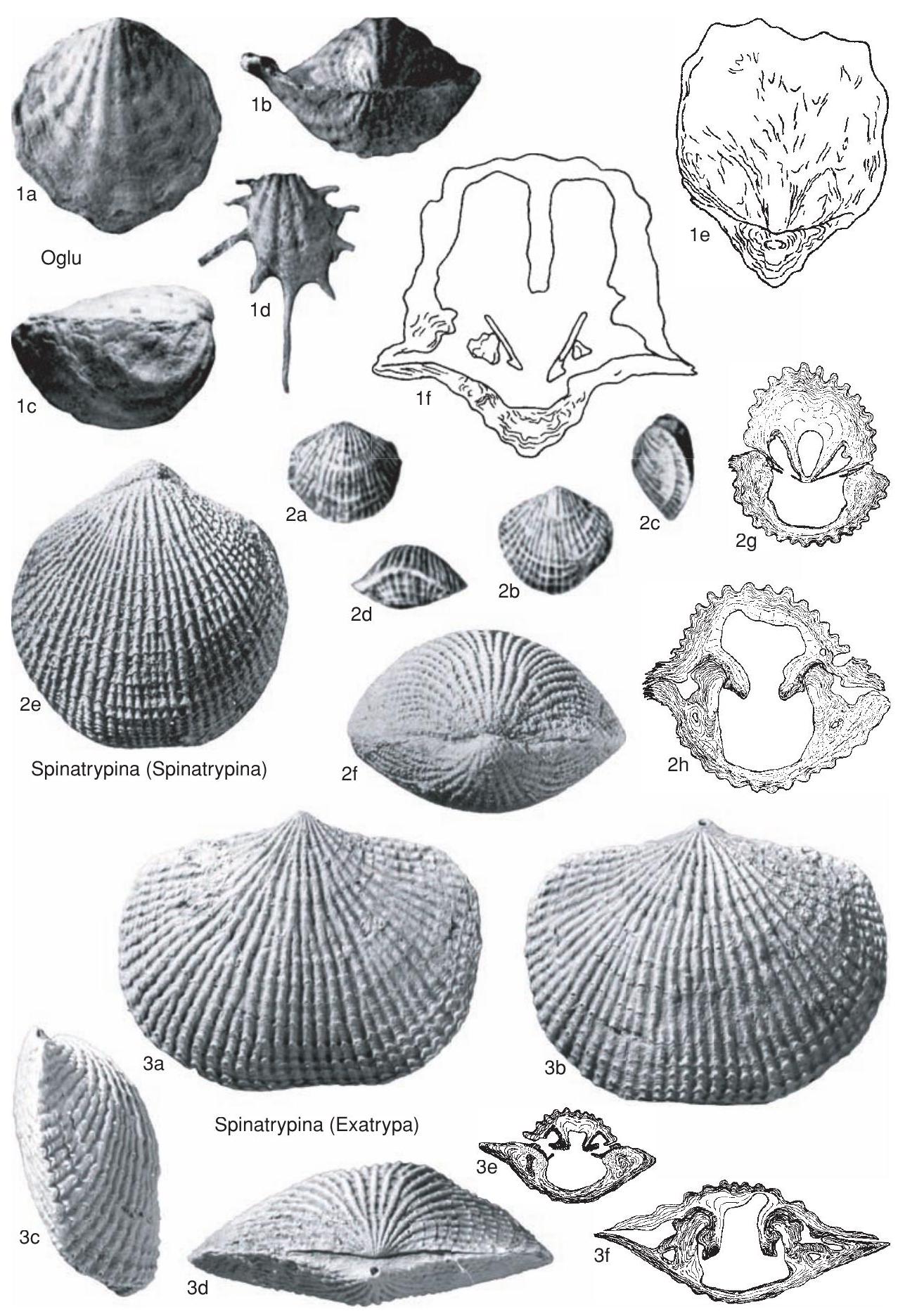Welcome to the Treatise on Invertebrate Paleontology!
Please enter a genera name to retrieve more information.

Spinatrypina
Classification
Phylum:
Brachiopoda
Subphylum:
Rhynchonelliformea
Class:
Rhynchonellata
Order:
Atrypida
Suborder:
Atrypidina
Superfamily:
Atrypoidea
Family:
Atrypidae
Subfamily:
Spinatrypinae
Formal Genus Name and Reference:
Spinatrypina Rzhonsnitskaia, 1964, p. 101
Type Species:
S. margaritoides, OD
Images
(Click to enlarge in a new window)
Fig. 957 ,2a–d. *S. (S.) margaritoides, Pragian, Siberia; dorsal, ventral, lateral, anterior views, ×1 (Rzhonsnitskaia, 1975).——Fig. 957 ,2e–h. S. (S.) soetenica (STRUVE), lower Givetian, Germany; e–f, dorsal, posterior views, × 2; g–h, serial sections, × 3 (Copper, 1967d).
Synonyms
Sibirispira
Geographic Distribution
worldwide
Age Range
Beginning Stage in Treatise Usage:
Silurian (?Ludlow, Pridoli)
Beginning International Stage:
Gorstian
Fraction Up In Beginning Stage:
0
Beginning Date:
426.74
Ending Stage in Treatise Usage:
Upper Devonian (Frasnian)
Ending International Stage:
Frasnian
Fraction Up In Ending Stage:
100
Ending Date:
371.1
Description
Small to medium, rounded, globose, biconvex to planar, short to longer hinge, small, orthocline area, protruding beak, apical foramen, deltidial plates, fine to medium-sized, tubular-imbricate ribs, spines lacking, short deflected, rhythmic growth lamellae producing strong imbrication, weakly plicate commissure, thin shell wall, lacking pedicle callist or collar, delicate, long teeth, small to large dental cavities, hinge and socket plates thin, delicate, crura straight or partly feathered, dorsomedial spiralia with fewer than 10 whorls, jugal processes tipped by small plates. [Distinct from Spinatrypa in fine, tubular-imbricate ribbing, delicate teeth with wide dental cavities, differs from Atrypinella and Reticulatrypa in larger size, short growth lamellae, coarser ribs, presence of dental cavities.]
References
Museum or Author Information
Classification
Phylum:
Brachiopoda
Subphylum:
Rhynchonelliformea
Class:
Rhynchonellata
Order:
Atrypida
Suborder:
Atrypidina
Superfamily:
Atrypoidea
Family:
Atrypidae
Subfamily:
Spinatrypinae
Formal Genus Name and Reference:
Spinatrypina Rzhonsnitskaia, 1964, p. 101
Type Species:
S. margaritoides, OD
Images
(Click to enlarge in a new window)
Fig. 957 ,2a–d. *S. (S.) margaritoides, Pragian, Siberia; dorsal, ventral, lateral, anterior views, ×1 (Rzhonsnitskaia, 1975).——Fig. 957 ,2e–h. S. (S.) soetenica (STRUVE), lower Givetian, Germany; e–f, dorsal, posterior views, × 2; g–h, serial sections, × 3 (Copper, 1967d).
Synonyms
Sibirispira
Geographic Distribution
worldwide
Age Range
Beginning Stage in Treatise Usage:
Silurian (?Ludlow, Pridoli)
Beginning International Stage:
Gorstian
Fraction Up In Beginning Stage:
0
Beginning Date:
426.74
Ending Stage in Treatise Usage:
Upper Devonian (Frasnian)
Ending International Stage:
Frasnian
Fraction Up In Ending Stage:
100
Ending Date:
371.1
Description
Small to medium, rounded, globose, biconvex to planar, short to longer hinge, small, orthocline area, protruding beak, apical foramen, deltidial plates, fine to medium-sized, tubular-imbricate ribs, spines lacking, short deflected, rhythmic growth lamellae producing strong imbrication, weakly plicate commissure, thin shell wall, lacking pedicle callist or collar, delicate, long teeth, small to large dental cavities, hinge and socket plates thin, delicate, crura straight or partly feathered, dorsomedial spiralia with fewer than 10 whorls, jugal processes tipped by small plates. [Distinct from Spinatrypa in fine, tubular-imbricate ribbing, delicate teeth with wide dental cavities, differs from Atrypinella and Reticulatrypa in larger size, short growth lamellae, coarser ribs, presence of dental cavities.]
